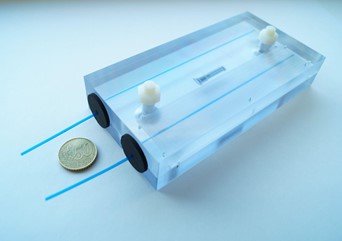Monte Carlo simulated correction factors of a novel phantom for brachytherapy dosimetry audits
Krzysztof Chelminski,
Austria
PD-0505
Abstract
Monte Carlo simulated correction factors of a novel phantom for brachytherapy dosimetry audits
Authors: Krzysztof Chelminski1, Roua Abdulrahim1, Alexis Dimitriadis1, Evelyn Granizo-Roman1, Jonathan Kalinowski2,3, Shirin Abbasi Enger2,3, Godfrey Azangwe1, Jamema Swamidas1
1IAEA - International Atomic Energy Agency, Department of Nuclear Sciences and Applications, Division of Human Health, Vienna, Austria; 2McGill University, Department of Oncology, Medical Physics Unit, Montreal, Canada; 3Lady Davis Institute for Medical Research, Jewish General Hospital, Montreal, Canada
Show Affiliations
Hide Affiliations
Purpose or Objective
Independent dosimetry audits have potential to prevent catastrophic errors and minimise systematic dose deviations in high dose rate HDR BT. The aim of this study was to obtain correction factors using MC method, to account for lack of scatter and non-water equivalence of phantom and dosimeter material as compared to the TG-43 conditions for a phantom geometry designed for IAEA/WHO postal dosimetry audits for HDR BT under the framework of a coordinated research project E24023.
Material and Methods
A PMMA phantom of 16 cm × 8 cm × 3 cm containing two channels on either side of a RPLD located at the centre of a phantom was simulated using RapidBrachyMCTPS for HDR Ir-192, model Ir2.A85-2 source.

RPLDs are made of silver-activated phosphate glass (FD7) with a 1.5 mm diameter and 12 mm length located inside a capsule made of high-density polyethylene (HDPE) were used in the simulation. Absorbed dose was scored in 1.25x 1.25 x1.25 mm^3 voxels and 5×10^7 primary particles were simulated balancing computation time and uncertainty.
Four cases were simulated (Table). Case 1 represents the TG-43 conditions of full scatter and water equivalent material, while case 2 mimic potential audit conditions, where the use of the PMMA, perturbation effects due to the presence of the RPLD, HDPE capsule, and the lack of scatter conditions of the phantom were simulated.
Scenarios with different thicknesses of backscatter material (5 cm, 10 cm and 15 cm of G4_water) were also simulated in case 3 to mitigate the influence of a table material (case 4) on which the PMMA phantom may be positioned.
Simulation cases
| Surrounding medium
| Phantom
| Backscatter
| Table
| RPLD capsule
| RPLD glass
|
1 (TG-43)
| Water
| Water
| Water
| Water
| Water
| Water
|
2 (Audit)
| Air | PMMA | Air | Air | HDPE
| FD7 |
3 (Audit)
| Air
| PMMA | Water
| Air | HDPE
| FD7
|
4 (Audit)
| Air
| PMMA | Water
| Steel | HDPE
| FD7
|
Results
The total estimated correction factor was 1.15 ± 0.02 for the audit case 2 in respect to case 1. The contributions of the individual correction factors were determined to be 1.06 ± 0.01, 1.05 ± 0.01 and 1.03 ± 0.01 for perturbation effects, the lack of scatter, and the use of PMMA, respectively.
The varying thicknesses of the backscatter for the audit case 3 increased the dose calculated in the detector in respect to case 1 by 12% ± 1%, 11% ± 1% and 12% ± 1% for thicknesses of 5 cm, 10 and 15 cm, respectively. For the audit case 4 with a steel table the corresponding results were 12% ± 1%, 11% ± 1% and 12% ± 1%. Varying thickness of backscatter material resulted in a similar dose rise to the detector, suggesting that 5 cm backscatter is adequate. Moreover, 5 cm backscatter is sufficient to ensure that the audit result will not be influenced by the density of the underlying table.
Conclusion
The results have provided an assessment of the magnitude of the correction factors, to account for lack of scatter, non-water equivalence of the phantom, dosimeter and the influence of the table material as compared to TG-43 conditions. Validations of these results using commercial model-based dose calculations are underway.